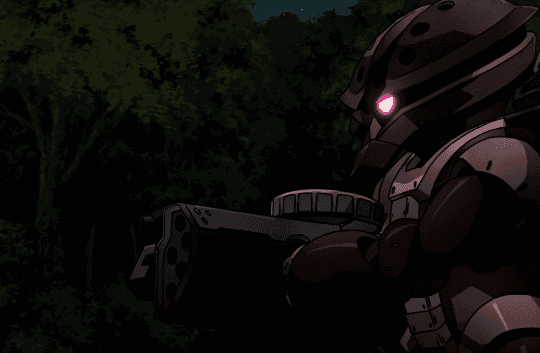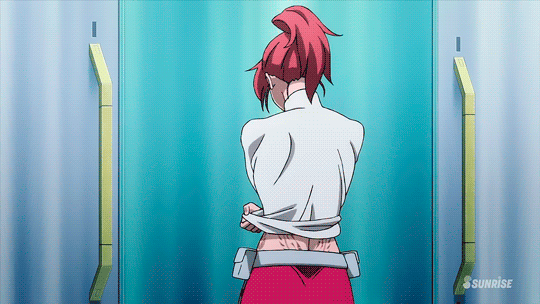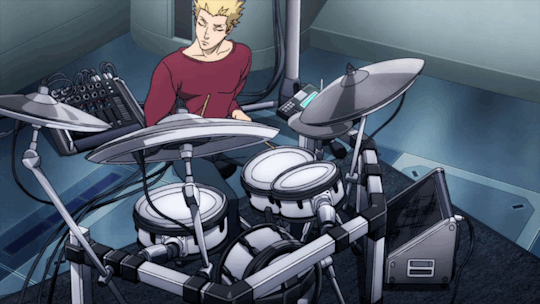originally posted at https://canmom.tumblr.com/post/708801...
144 is 12 squared. Squares are kinda robot like. Ergo we’re watching Gundam. Impeccable logic I’m sure you’ll agree.

Check it out, it’s an Itano circus.
Gundam! Over the course of Animation Night I’ve gone from being someone who doesn’t know the first thing about Gundam (back when I wrote Animation Night 88 on the history of robot anime and Animation Night 94 on Tomino’s “New Anime Century” and ‘anti-war’ fiction) to someone who is developing a fondness for its particular brand of scifi melodrama.
Gundam Thunderbolt is set in the core Universal Century timeline, but it approaches it with a mind towards changing and dismantling; the author of the manga, Yasuo Ohtagaki, even spoke of ‘always trying to identify which parts of Gundam must be destroyed’ - destruction and subversion being what he considers the original spirit of Gundam.

Gundam Thunderbolt thus begins in a time period concurrent with the original Gundam TV series, with the Federation and Zeon battling on Earth in a ‘Thunderbolt Sector’ littered with space debris. On the Federation’s side are survivors of one of the destroyed space colonies wishing revenge; on Zeon’s is a special unit of amputee pilots. Before long, however, the conflict develops a third faction with the Buddhist radicals in the ‘South Seas Alliance’, which declares its secession from the Federation.
But it’s Gundam, so the focus of the story is on a handful of characters caught in the middle of it. On the Federation side we have Io Fleming, an ensign with a passion for music, and his lover Claudia Peer, a spaceship captain deeply depressed at the long war. On Zeon’s side comes Daryl Lorenz, double leg amputee, and Karla Mitchum, a caring scientist specialising in prosthetics. Early on in the conflict, Io causes Daryl to lose yet another limb - but rather than pack up and leave the war, he volunteers to undergo a further amputation for full integration into a brain controlled Gundam.
The manga is still ongoing, but the first arc was written with the intent of being adapted into a movie, and indeed Sunrise did just that. The first form of Thunderbolt was an eight-episode ONA series released on the web from 2015-2017. Concurrently, this was recut as a pair of compilation movies, titled December Sky and Bandit Flower.

(look it has girls and robots!)
Gundam has gone through many hands since Tomino’s day, and the principle factions of the Universal Century setting have been interpreted in a number of ways - something that anituber Pyramid Inu discusses nicely here. At the time Ohtagaki was writing in the mid 2010s, the mainstream Gundam airing was the Unicorn series (OVAs and then a TV show), written by Harutoshi Fukui, a writer who began his career writing Tom Clancy-like stories with a nationalist bent. He toned this down when he took over Gundam, describing himself as a ‘JJ Abrams’ type figure; nevertheless his Gundam presented a heavy-handedly war-on-terror inspired story in which the Federation is cast as America fighting Muslim militants.
Ohtagaki’s vision also emphasises religion, but instead puts the focus on a more familiar Buddhism, taking aim at what he sees as unreasonable suspicion towards religion in modern Japan (source)…
If you depict people who believe in Buddhism in a manga, people call that a cult. He points out that that way of thinking is already biased and feels that it points out people’s ignorance towards religion. He laments that if you look at it from a global perspective or even consider the history of humanity, the lack of religious beliefs among Japanese people today is quite unusual. He says that it’s a significant problem for Japan today to accept and tolerate other people’s beliefs, so much so that just because someone appears chanting sutras, they’re branded a cult.
He says that assumptions like that are far more dangerous. He’s not out to portray the South Seas Alliance as an ally of justice, nor their religious beliefs as righteous, it’s just that Japanese people close their eyes and try not to see them. He’s illustrating all this because he wants people to realize that it’s strange to think there is no such thing, that it’s more than a little unnatural that there were no religions in the world of Gundam in the first place.

Ohtagaki aimed to sidestep Gundam conventions in other ways: an adult protagonist, a stronger emphasis on chain of command. On the matter of ‘anti-war’, he takes a more fatalistic, small-scale stance:
In anime, the side the protagonist is on always ends up looking like the side that’s in the right. But both the Federation and Zeon are just countries, so it shouldn’t be about wrong and right. I don’t think there’s any point in inserting your ideologies in a manga. For people with normal lives, nations and wars are the ultimate kind of violence, and I want to draw the best ways to handle being in a war in order to survive.
So I’m not anti-war either. Wars will continue to happen, and I don’t think we’ll ever be rid of them, so the most important thing is to know how to handle them. But there aren’t that many people in Japan who think about things in that way. It’s correct to say that you’re anti-war or that there shouldn’t be war, so if you look at things as though war is inevitable, people think that you’re pro-war and you’re a bad person. But I think that’s a very narrow way of thinking, and it actually shows a lack of historical knowledge.
What do I think of that, eh? Right now, mostly ‘hmm’. Ohtagaki is correct to recognise that ‘will wars happen’ and ‘should wars happen’ are different questions; there’s also the question of ‘if war shouldn’t happen, how can it be prevented’. To say ‘war is inevitable’, even if is true, is not to commit to any particular war being inevitable. But it’s also true that there’s no need for all fiction about wars to try and take them on!
I can’t entirely comment on this until I’ve seen the movies, so put a pin there; but given the morass of ‘what does it mean to make true anti-war fiction’, deciding to sidestep the issue entirely is perhaps an understandable move. I’ll be curious to see what focus this approach gives the films; if previous Gundams have approached ‘anti-war narrative’ through focusing on the futility of going to war and the hope for some kind of new-age transcendance (original Gundam), the tragedy of civilians caught up in the middle (War in the Pocket), or the story of a soldier who tries to avoid killing (08th MS Team), what will a story that’s more about just trying to survive look like?
Anyway, so far we’ve focused on the writer and the manga. Let’s actually talk about animation.

Thunderbolt was animated at Sunrise Studio 1, known as one of the bastions of the gradually dying art of 2D mecha animation, as well as character animation with an impressive sense of space. More recently, they impressed everyone with Gundam Hathaway (Animation Night 124).
So Gundam Thunderbolt abounds with complex shouts and detailed designs moving through space, leaning on the talents of e.g. Nobuhiko Genma and Kazuki Ito who animated this incredible POV shot, or Shingo Tamagawa of Puparia fame who provides this splendid character animation. In the late 2010s, we are firmly in the digital compositing era, and glows, flares, gradients and high contrast backgrounds abound, but even though this isn’t entirely to my taste I can’t deny just how splendid the underlying drawings are. The character designs are on the realist end of the scale, and they float around with the classic Sunrise sensitivity to 3D space.
Mecha destruction is given a particularly impressive level of flair, with beam swords and lasers slicing up robots and splattering hot metal all over to the point that it starts to feel like a gory samurai movie. All in all it looks intense and compelling: the product of decades of development by some of the best in their craft. It manages to retain clarity of very complex designs even as they move around wildly. It’s even got some cool oldschool lighting effects…

A question that may be asked is, if mecha animation is mostly about animating complex, rigid 3D shapes, why not do it on the computer, which excels at exactly that? One answer is that there’s a certain quality of movement that comes from planning everything out in 2D. Low framerates can be used to create a sense of weight and avoid the ‘toyetic’ feeling that comes from overly-smooth CG without considerable effort put in to avoiding it.
Another is that 2D gives you a different approach to composition, which allows you to subtly exaggerate and stylise or just frame things in a way that puts the layout in the camera first without constraint - the reason that Houseki no Kuni planned out its action scenes in great detail in 2D before animating them in 3D. Then there’s just the ‘feeling’ of 2D, the slight errors and roughness giving it a more lively, organic feeling. Finally we might add the effect of limitations and constraints as structure.
That said, the ‘2D feel’ of a digitally composited series like Thunderbolt is not the same ‘2D feel’ as a 90s OVA like 08th MS Team. Working digitally makes some aspects of the workflow easier - you can easily preview a motion and scroll through the timeline - which makes some of these extremely complex shots possible. But conversely it is associated with faraway objects becoming indistinct blobs - this is I believe what is referred to as ‘douga melt’. Thunderbolt in all these clips looks very ‘2010s’. Which makes me wonder what the characteristic look of 2020s anime will turn out to be…
I think that will suffice for an introduction/study log/whatever these posts are! Animation Night 144 will begin at 8pm UK time, about two hours from this post! Movies will start at about 8:20pm. It will be at twitch.tv/canmom! Hope to see you there~
Comments